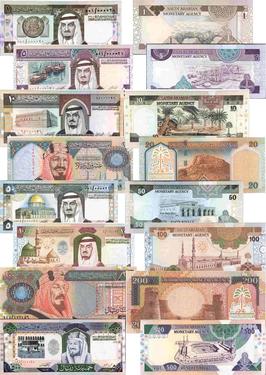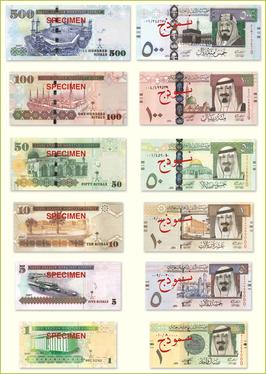Saudi riyal facts for kids
Quick facts for kids Saudi riyal |
|||
|---|---|---|---|
|
|||
| ISO 4217 Code | SAR | ||
| User(s) | |||
| Inflation | -2.09% (Average of 2019) | ||
| Source | Saudi Central Bank, Jan 2014 est. | ||
| Pegged with | U.S. dollar (USD) $1 USD = 3.75 SAR |
||
| Subunit | |||
| 1⁄100 | halalah | ||
| Symbol | SAR, SR, ر.س | ||
| halalah | halalas | ||
| Coins | 1, 5, 10, 25, 50 halalas, 1 riyal, 2 riyals | ||
| Banknotes | |||
| Freq. used | 5, 10, 50, 100, 500 riyals | ||
| Rarely used | 1, 20, 200 riyals | ||
The Saudi riyal (Arabic: ريال سعودي) is the official money used in Saudi Arabia. People often shorten its name to SAR or SR. One Saudi riyal is made up of 100 smaller units called halalas (Arabic: هللة).
The Saudi riyal is "pegged" to the US dollar. This means its value is kept stable and directly linked to the US dollar. For example, 1 US dollar is always worth 3.75 Saudi riyals. This helps keep prices steady and makes trade easier.
Contents
History of the Saudi Riyal
The riyal has been the money of Saudi Arabia since the country was formed. Before that, it was used in a region called Hejaz. It was also one of the main types of money used in the Mediterranean area during the time of the Ottoman Empire.
The early Hejaz riyal was similar to the Ottoman 20 kuruş coin. It was divided into 20 qirsh. The first Saudi riyal was like the Hejaz riyal. It was worth 22 Ottoman kuruş and was divided into 22 ghirsh when coins were first made in 1925.
In 1960, the system changed so that 20 qirsh made one riyal. Then, in 1963, the halala was introduced. One halala is one hundredth of a riyal. Some Saudi coins still show their value in qirsh, but people don't use that term much anymore.
Coins of Saudi Arabia
In 1925, the first small copper coins were made in Mecca. These were for 1⁄4 and 1⁄2 qirsh. In 1926, cupro-nickel coins for 1⁄4, 1⁄2, and 1 qirsh were made. These coins had the title "King of Hejaz and Sultan of Nejd."
In 1927, the king's title changed to "King of Hejaz and Nejd and Dependencies." New coins were made in cupro-nickel for 1⁄4, 1⁄2, and 1 qirsh. Silver coins for 1⁄4, 1⁄2, and 1 riyal were also released.
The first coins with the name Saudi Arabia were made in 1935. These were silver 1⁄4, 1⁄2, and 1 riyal coins. They were much lighter than the older ones. Cupro-nickel coins for 1⁄4, 1⁄2, and 1 qirsh also came out in 1937.
In 1963, the halala was introduced with bronze 1 halala coins. In 1972, cupro-nickel coins for 5, 10, 25, and 50 halalas were released. These coins also showed their value in ghirsh or riyal. In 1976, 1 riyal coins were introduced, which also said "100 halala."
New coins for 1, 5, 10, 25, and 50 halalas, and 1 and 2 riyal coins were released in 2016.
Banknotes of Saudi Arabia
In 1953, the Saudi Arabian Monetary Agency (SAMA) started printing special "Hajj Pilgrim Receipts." These were like banknotes for 10 riyals. Later, 1 and 5 riyal receipts were also made. They were first meant for pilgrims to exchange foreign money.
However, these receipts became very popular and were used like regular money across Saudi Arabia. So, in 1961, the Monetary Agency began printing official banknotes for 1, 5, 10, 50, and 100 riyals. The Pilgrim Receipts were stopped in 1965.
Bigger 500 Riyal notes were introduced in 1983. To celebrate 100 years since the founding of Saudi Arabia, 20 and 200 riyal banknotes were released in 2000.
Fifth Series of Banknotes (2007–2016)
On May 20, 2007, the Saudi Arabian Monetary Agency announced a new series of banknotes. These notes featured a picture of King Abdullah on all notes, except for the 500 riyals note, which showed King Abdulaziz.
The 100 and 50 riyal notes were released first in May 2007. The 10 and 5 riyal notes followed in June 2007. The 500 riyal note came out in September 2007, and the 1 riyal note completed the series in December 2007. These new notes had advanced security features to prevent fake money.
Sixth Series of Banknotes (2016–Present)
The Saudi Arabian Monetary Authority released a new set of banknotes in 2016. These notes feature the portrait of King Salman on the 5 to 100 riyal notes. The 500 riyal banknote still shows King Abdulaziz Al Saud.
In 2020, the 5 riyal note was updated to be made from a special plastic material called polymer. This makes the note more eco-friendly, harder to fake, and last longer than paper notes.
A special 20 riyal note was released in 2020 to celebrate the G20 meeting. This note showed a world map on its back.
Fixed Exchange Rate Explained
Since June 1986, the Saudi riyal has been officially linked to the IMF's special drawing rights (SDRs). In simple terms, it means the value of the riyal is kept steady against the United States dollar.
The official rate is 1 U.S. dollar = 3.75 Saudi riyals. This rate became official on January 1, 2003. This fixed rate helps keep the Saudi economy stable and predictable.
Future Plans for Currency
Saudi Arabia is part of the Cooperation Council for the Arab States of the Gulf. This group of countries once planned to create a single currency for all members by 2010. However, for now, each country in the GCC still uses its own currency.
See also
 In Spanish: Riyal saudí para niños
In Spanish: Riyal saudí para niños
- Banks in Saudi Arabia
- Economy of Saudi Arabia
- Iranian rial
- Omani rial
- Qatari riyal
- Yemeni rial




